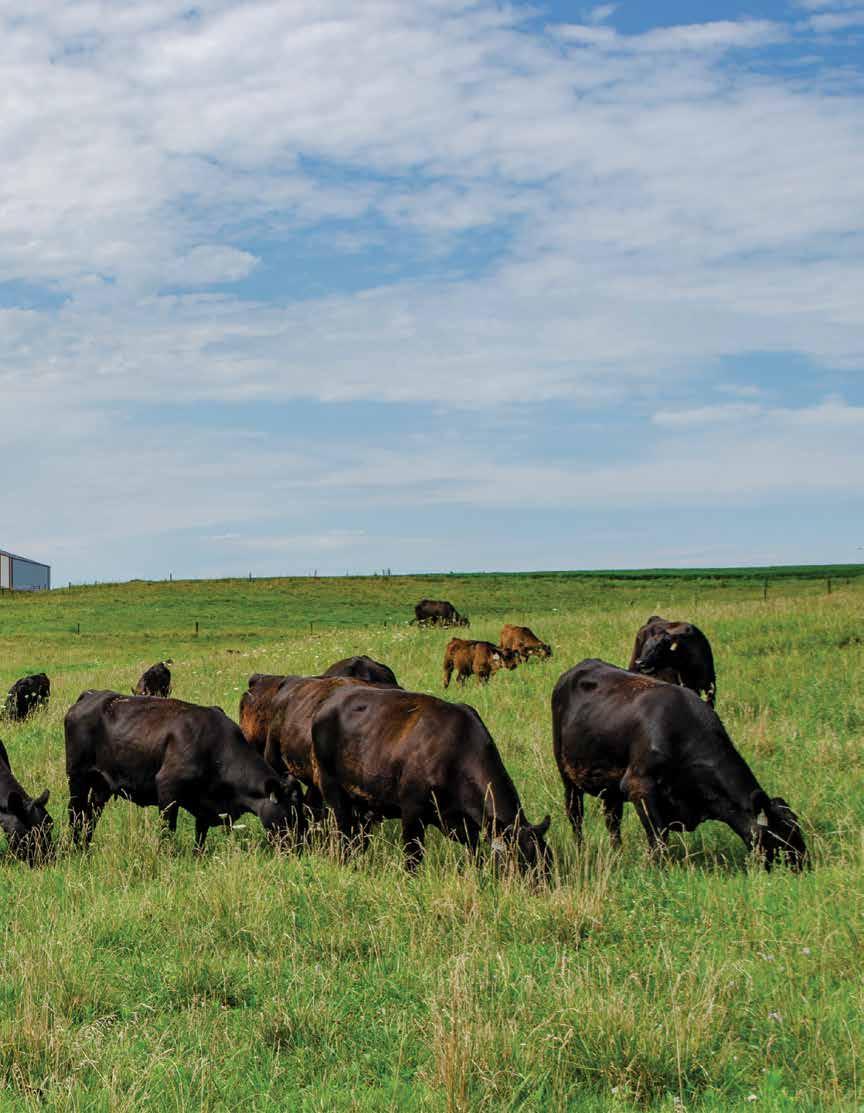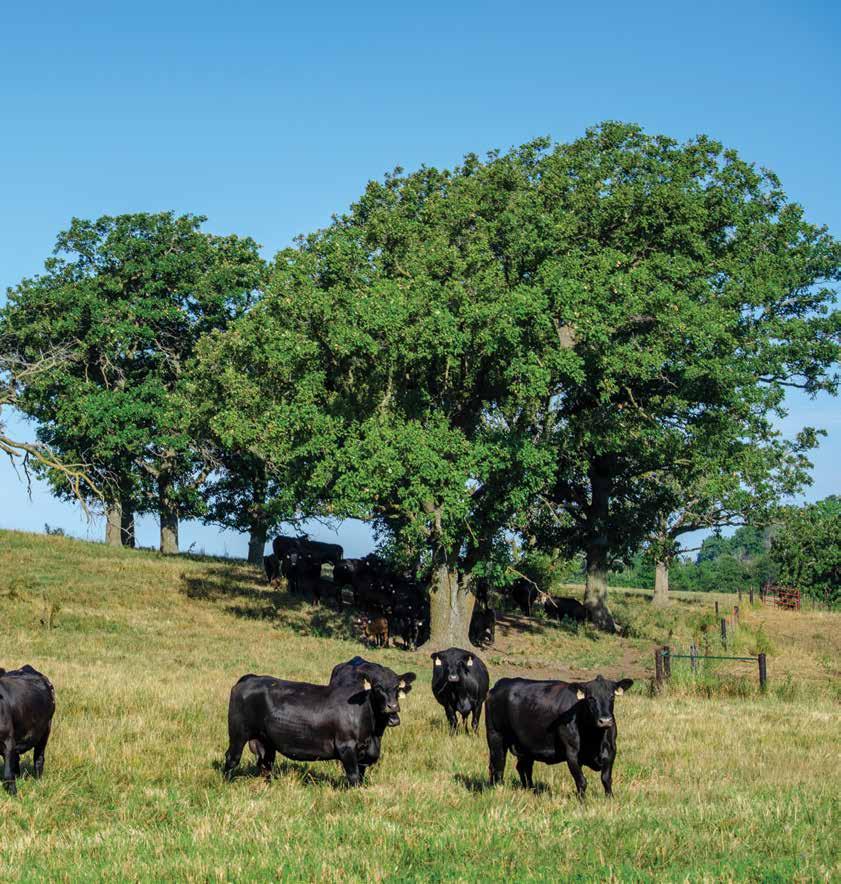
7 minute read
HERD HEALTH
by NCBA

Herd Health Planning – A Collaborative Effort
Advertisement
Julia Herman, DVM, MS, Beef Cattle Specialist Veterinarian, National Cattlemen’s Beef Association
Our cattle industry has demonstrated adaptability in several instances over the past year. Whether it was a natural disaster, sick employees or feed availability, cattle producers can pivot to a new plan when necessary. How does that adaptability apply to the operation’s herd health plan? What happened in the past year that will require a herd health plan adjustment? Herd health plans are always changing because they match the diversity of cattle operations we have in the U.S. Those plans can differ regionally based on weather, feed availability, breed, parasite risk, and the list goes on. With these influences, cattlemen and women are constantly challenged to adapt their herd plan to their current resources and business model to continue providing the best care for their cattle. While not an easy task, having external advisors can provide an objective view of the herd health plan and find opportunities to improve productivity of the farm or ranch. This is where the herd veterinarian and the veterinarian-clientpatient relationship serves a valuable role.
Veterinarian-client-patient relationship
Building relationships is key in the cattle industry, especially when considering the veterinarian-client-patient relationship (VCPR). This collaboration between the cattle producer and their herd veterinarian is essential to advancing the well-being of the animals. “Herd health planning requires much communication between the veterinarian and the producer,” said Heidi Ward, Extension veterinarian at the University of Arkansas system division of agriculture and Arkansas Beef Quality Assurance (BQA) coordinator. “This information is what the veterinarian needs to know to provide you, the producer, the best advice and care which ultimately leads to improved productivity for the animals and the operation.” Developing that relationship of trust with the veterinarian includes a site visit where the veterinarian can evaluate the herd characteristics, environmental factors such as waterways or toxic plants specific to your area, and the producer’s goals for their cattle. Ward added, for instance, seedstock producers will have different goals than part-time farmers, and the veterinarian should customize the herd health plan to each operation. Opportunities lie in a number of areas, such as: • Animal health with updated vaccine protocols, understanding responsible antibiotic use and optimizing nutrition through the seasons • Preparing the animal’s immune system by mitigating environmental stressors such as weather and weaning and providing proper nutrition for that animal’s age and purpose • Training for producers and their employees in areas such as record keeping, cattle handling, antibiotic stewardship and humane euthanasia
Reviewing vaccination, deworming and treatment plans on at least an annual basis is recommended so the programs can be adapted to new circumstances. “Preventing infectious disease through planned vaccination strategies is critical to every cattle operation,” said Gerald Stokka, North Dakota State University Extension service veterinarian. “Producers should develop protocols in consultation with their veterinarian, and those strategies should be risk-based and researched for the area.” With all preventive strategies, there are three principles that Stokka recommended producers and veterinarians to consider when implementing vaccination and other treatment protocols: • Necessity - Is the risk of exposure high enough that clinical disease and pathogen transmission will become a health and well-being issue beyond their expectations for the herd?
• Efficacy - Does scientific evidence or observational experience indicate that product selection for specific pathogens is effective for the level of exposure and stress of the herd?
• Safety - Does evidence indicate that the product will not cause harm through local or systemic reactions? Ensuring you are using the proper preventive treatment for your herd and administering it at the proper time for the animal’s immune system to react is critical. Vaccinating calves and adult cattle at strategic times throughout the year primes their immune systems and allows the immune response to protect from future exposure. The major pathogen groups that are vaccinated against include the respiratory pathogens that contribute to bovine respiratory disease (BRD) and the Clostridium family that may cause diseases such as blackleg, tetanus and others. Respiratory pathogens of concern include Infectious Bovine Rhinotracheitis (IBR), Bovine Viral Diarrhea Virus (BVDV), Bovine Respiratory Syncytial Virus (BRSV) and Mannheimia haemolytica. Other vaccination considerations include protection against reproductive diseases such as leptospirosis and campylobacteriosis (previously known as vibriosis). Selection of route of administration, i.e., subcutaneous, intranasal or in the muscle, varies by product label and can be another strategy to discuss with your veterinarian. Parasite management varies by region with differences in climate, environmental conditions, host susceptibility and farm/ ranch management practices. To effectively treat or manage parasites in the herd, it is important to know exactly which ones are a problem. Working with your local veterinarian and Extension agent will help tailor a strategy to the specific operation, using multiple modalities to protect your herd. Preventing resistance in the animal health realm can apply to

both antimicrobial and antiparasitic products. Anthelmintic (or dewormer) resistance has become a real threat to prevention and control of internal parasites (i.e., worms) in livestock as decades of overuse have decreased the utility of certain classes of anthelmintics and treatment protocols have become more complex than giving a single product and necessitate veterinary consultation.
Nutrition and Environment
Nutrition management varies with life stage and purpose of the animal and nutrient requirements will change with each season. Ward emphasized, “What happens in the gut will determine the immune health of that animal and how well that animal’s immune system will function.” Feeding cattle the right balance of energy, protein, vitamins and minerals to meet their requirement during growth, maintenance and gestation stages can be complex. The immune system relies on proper nutrition, especially trace minerals, to perform optimally. When pasture and forage is limited during winters or dry weather, cattle require supplemental protein and energy. Nutritional stress will reduce production of the animals and can increase health risks by impairing immune function. Maintaining an adequate body condition score near 5-6 for adult animals is a general goal. Nutrition throughout gestation will affect the calf’s productivity throughout their lifetime, from immune system development in utero to colostrum providing passive immunity. Establishing a feeding plan and evaluating regional feedstuff supplies is another step to the herd health plan. Minimizing environmental stressors also improves immune system response and resiliency. Wet and windy conditions can negatively impact calves quickly and require extra time and resources for proper care. Heat stress in the summer can also impact vaccine response and productivity. Plan ahead when working cattle with weather forecasts, proper animal handling training and supporting cattle through bad weather with dry bedding or windbreaks.
Training Opportunities
Training new or seasoned personnel is another critical area of the herd health plan and starts with proper record keeping. Cattle producers can stay organized by maintaining good records that document what has already been done and plan for future steps. From recording birthdates to parental information to withdrawal periods and safe to ship dates, these records allow the rancher to responsibly care for and market each of their animals with confidence. The checkofffunded BQA program provides guidance on types of records to consider.

The beef industry continues to produce safe, high quality products while adhering to these BQA principles. Judicious use of antibiotics and animal health products are the foundation of any treatment plan and starts with correctly diagnosing a problem and choosing the correct product, if even necessary. While much focus is placed on withdrawal times for antibiotics, do not forget that many topical and injectable parasite treatments and vaccines have withdrawal periods to adhere to. Proper dosing to bodyweight of the animal plays a role in effectiveness of the medications, also. Animal treatment records are critical in establishing withdrawal times and preventing residues in the food supply. Opportunities in improving animal handling through training in natural cattle behavior and low-stress handling can lead to a safer working environment for both the workers and cattle. Training in biosecurity practices on the operation should be offered to personnel and visitors. Contingency planning for natural disasters could be another training opportunity to add to the herd health plan. All personnel working with the cattle should be made aware of the various treatment, animal care and safety protocols in place. We have learned that herd health plans are unique to each enterprise and encompass much more than vaccinating animals. Stokka said, “Livestock veterinary professionals have been trained to provide more than just individual treatments and surgery; they’re also trained to be a consulting member of beef cattle operations.” The invaluable relationship between cattle producers and their herd veterinarians strengthens their commitment to animal care and moves each producer closer to their short-term and long-term goals towards profit and sustainability. Herd health plans evaluate each aspect of the business and will provide each operation a roadmap to success.










